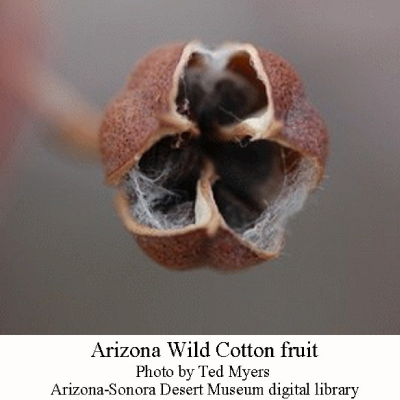
 Commercially-grown cotton is one of Arizona’s five “Cs” (Cattle, Copper, Citrus, Cotton and Climate) and is important to the economy. There is a wild cotton plant, native to the Sonoran Desert, which some think may be a progenitor of the cultivated product: Arizona Wild Cotton (Gossypium thurberi), also called Desert Cotton and Thurber’s Cotton.
Commercially-grown cotton is one of Arizona’s five “Cs” (Cattle, Copper, Citrus, Cotton and Climate) and is important to the economy. There is a wild cotton plant, native to the Sonoran Desert, which some think may be a progenitor of the cultivated product: Arizona Wild Cotton (Gossypium thurberi), also called Desert Cotton and Thurber’s Cotton.
This plant is relatively common in the foothills around Tucson and can be seen in the “Grasslands” exhibit at the Arizona-Sonora Desert Museum. It can grow up to 10 feet tall.
In the spring, Arizona Wild Cotton will produce pretty, white, cupped flowers which may have spots of pink; The flowers, which are one to two inches in diameter, turn fully pink to lavender with age. (That is the red seen in the first photo.)
After the flowers are pollinated, mainly by bees, they turn into a hard-shelled fruit, or bolls, about a half-inch in diameter. With age, the bolls open to reveal white to grayish fibers.
You can see more photos from The Firefly Forest, the last of which shows how many of the leaves turn scarlet before falling off.
Because this wild shrub is a close relative to cultivated cotton, it shares several of the same pests such as the Pink Bollworm. It is used as a larval food plant for the royal moth (Citheronia splendens sinaloensis).
According to Arizonensis.org:
“In the 1930’s attempts were made to eradicate this plant from the mountains and foothills of southern Arizona. The reason being that a weevil (small beetle) that feeds within the developing bolls was thought to be the same as the infamous Cotton Boll Weevil. Later, taxonomic studies by Dr. Floyd Werner determined that the Thurber Weevil was not the same and that it did not affect cultivated cotton. Luckily the eradication efforts failed and the plant has returned to be a common, attractive plant. Thurber’s Cotton makes a nice addition to xeriscape gardens and can be pruned to become a ‘cotton tree’.”
Tinctures made from the bark of cotton plant roots are claimed to relieve a variety of conditions, see WebMD.
See articles about other desert plants:
Spectacular flowers of the red Torch Cactus
Oak trees of the Sonoran Desert region
Joshua Trees of the Mohave Desert
Agaves provide food, fiber and adult beverages
Ocotillo – an aide to hummingbirds and geologists
Chiltepin peppers, spice and medicine
Saguaro Cactus Icon of the Sonoran Desert
Yuccas provide food, fiber, and soap
The Jojoba bush and its valuable oil
Mesquite trees provide food, fuel, medicine, and more

